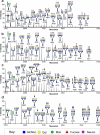Global metabolic inhibitors of sialyl- and fucosyltransferases remodel the glycome
- PMID: 22683610
- PMCID: PMC3427410
- DOI: 10.1038/nchembio.999
Global metabolic inhibitors of sialyl- and fucosyltransferases remodel the glycome
Abstract
Despite the fundamental roles of sialyl- and fucosyltransferases in mammalian physiology, there are few pharmacological tools to manipulate their function in a cellular setting. Although fluorinated analogs of the donor substrates are well-established transition state inhibitors of these enzymes, they are not membrane permeable. By exploiting promiscuous monosaccharide salvage pathways, we show that fluorinated analogs of sialic acid and fucose can be taken up and metabolized to the desired donor substrate-based inhibitors inside the cell. Because of the existence of metabolic feedback loops, they also act to prevent the de novo synthesis of the natural substrates, resulting in a global, family-wide shutdown of sialyl- and/or fucosyltransferases and remodeling of cell-surface glycans. As an example of the functional consequences, the inhibitors substantially reduce expression of the sialylated and fucosylated ligand sialyl Lewis X on myeloid cells, resulting in loss of selectin binding and impaired leukocyte rolling.
Figures





Similar articles
-
Expression patterns of alpha 2,3-sialyltransferases and alpha 1,3-fucosyltransferases determine the mode of sialyl Lewis X inhibition by disaccharide decoys.J Biol Chem. 2003 Jun 27;278(26):23352-9. doi: 10.1074/jbc.M303093200. Epub 2003 Apr 9. J Biol Chem. 2003. PMID: 12686549
-
High-throughput screening for inhibitors of sialyl- and fucosyltransferases.Angew Chem Int Ed Engl. 2011 Dec 23;50(52):12534-7. doi: 10.1002/anie.201105065. Epub 2011 Nov 9. Angew Chem Int Ed Engl. 2011. PMID: 22095645 Free PMC article.
-
Metabolic inhibition of sialyl-Lewis X biosynthesis by 5-thiofucose remodels the cell surface and impairs selectin-mediated cell adhesion.J Biol Chem. 2012 Nov 16;287(47):40021-30. doi: 10.1074/jbc.M112.403568. Epub 2012 Sep 27. J Biol Chem. 2012. PMID: 23019334 Free PMC article.
-
Fucosylation in prokaryotes and eukaryotes.Glycobiology. 2006 Dec;16(12):158R-184R. doi: 10.1093/glycob/cwl040. Epub 2006 Sep 14. Glycobiology. 2006. PMID: 16973733 Review.
-
Fucose: biosynthesis and biological function in mammals.Glycobiology. 2003 Jul;13(7):41R-53R. doi: 10.1093/glycob/cwg054. Epub 2003 Mar 19. Glycobiology. 2003. PMID: 12651883 Review.
Cited by
-
The immunoglobulin G1 N-glycan composition affects binding to each low affinity Fc γ receptor.MAbs. 2016 Nov/Dec;8(8):1512-1524. doi: 10.1080/19420862.2016.1218586. Epub 2016 Aug 5. MAbs. 2016. PMID: 27492264 Free PMC article.
-
Expression of the Carbohydrate Lewis Antigen, Sialyl Lewis A, Sialyl Lewis X, Lewis X, and Lewis Y in the Placental Villi of Patients With Unexplained Miscarriages.Front Immunol. 2021 May 31;12:679424. doi: 10.3389/fimmu.2021.679424. eCollection 2021. Front Immunol. 2021. PMID: 34135905 Free PMC article.
-
Targeted Approaches to Inhibit Sialylation of Multiple Myeloma in the Bone Marrow Microenvironment.Front Bioeng Biotechnol. 2019 Oct 4;7:252. doi: 10.3389/fbioe.2019.00252. eCollection 2019. Front Bioeng Biotechnol. 2019. PMID: 31637237 Free PMC article. Review.
-
Combined sialic acid and histone deacetylase (HDAC) inhibitor treatment up-regulates the neuroblastoma antigen GD2.J Biol Chem. 2019 Mar 22;294(12):4437-4449. doi: 10.1074/jbc.RA118.002763. Epub 2019 Jan 22. J Biol Chem. 2019. PMID: 30670592 Free PMC article.
-
Genome-wide CRISPR/Cas9 Screen Identifies Host Factors Essential for Influenza Virus Replication.Cell Rep. 2018 Apr 10;23(2):596-607. doi: 10.1016/j.celrep.2018.03.045. Cell Rep. 2018. PMID: 29642015 Free PMC article.
References
-
- Varki A, et al. Essentials of Glycobiology. Cold Spring Harbor Laboratory Press; Cold Spring Harbor, NY: 2009. - PubMed
-
- Becker D, Lowe J. Fucose: biosynthesis and biological function in mammals. Glycobiology. 2003;13:41R–53R. - PubMed
-
- Varki A. Glycan-based interactions involving vertebrate sialic-acid-recognizing proteins. Nature. 2007;446:1023–9. - PubMed
-
- Lowe JB, Marth JD. A genetic approach to Mammalian glycan function. Annu Rev Biochem. 2003;72:643–91. - PubMed
-
- Maly P, et al. The alpha(1,3)fucosyltransferase Fuc-TVII controls leukocyte trafficking through an essential role in L-, E-, and P-selectin ligand biosynthesis. Cell. 1996;86:643–53. - PubMed
Publication types
MeSH terms
Substances
Associated data
- PubChem-Substance/135676652
- PubChem-Substance/135676653
- PubChem-Substance/135676654
- PubChem-Substance/135676655
- PubChem-Substance/135676656
- PubChem-Substance/135676657
- PubChem-Substance/135676658
- PubChem-Substance/135676659
- PubChem-Substance/135676660
- PubChem-Substance/135676661
- PubChem-Substance/135676662
- PubChem-Substance/135676663
- PubChem-Substance/135676664
- PubChem-Substance/135676665
Grants and funding
- T32 AI007606/AI/NIAID NIH HHS/United States
- R01 HL111969/HL/NHLBI NIH HHS/United States
- R01AI050143/AI/NIAID NIH HHS/United States
- P01 HL107151/HL/NHLBI NIH HHS/United States
- P41 RR018502/RR/NCRR NIH HHS/United States
- 1 P41 RR018502-01/RR/NCRR NIH HHS/United States
- BBF0083091/BB_/Biotechnology and Biological Sciences Research Council/United Kingdom
- R01HL111969/HL/NHLBI NIH HHS/United States
- R01 AI050143/AI/NIAID NIH HHS/United States
- P01HL107151/HL/NHLBI NIH HHS/United States
- T32 AI060536/AI/NIAID NIH HHS/United States
- T32AI060536/AI/NIAID NIH HHS/United States
- T32AI007606/AI/NIAID NIH HHS/United States
LinkOut - more resources
Full Text Sources
Other Literature Sources
Research Materials

